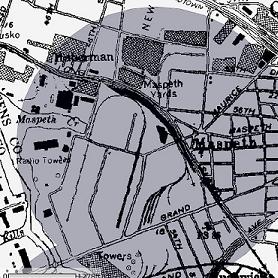ARCHAEOLOGICAL POTENTIAL RECOGNIZED BY CITY AND STATE
Councilman wants to create housing project on site.
(February 13, 2007) In two shocking revelations, both the NYS Office of Historic Preservation and the NYC Landmarks Preservation Commission (LPC) have admitted that the St. Saviour’s site contains the potential for recovery of archaeologically significant materials, including human remains.
Juniper Park Civic Association (JPCA) has long argued that the St. Saviour’s site is likely to contain historical artifacts and possibly burials. Both LPC and SHPO ignored those claims and quickly rejected the property.
However, archaeologist Linda Stone recently uncovered two key pieces of information during her research that prove that the LPC & SHPO knew that JPCA claims were valid, yet withheld this evidence while repeatedly rejecting the civic association’s applications for landmark designation and listing on the state historic register.
Amanda Sutphin, an archaeologist for LPC, wrote in an Environmental Review letter dated August 3, 2006: “LPC review of archeological sensitivity models and historic maps indicates that there is potential for the recovery of remains from 19th Century occupation for the … borough, block and lot locations within the study area … Also, the question of the presence or absence of human burials on this portion of the property needs further investigation and resolution.”
A map obtained by Ms. Stone from the New York State Historic Preservation Office shows that the St. Saviour’s site sits within an area deemed by the state to have high archaeological potential. (A copy of this map is attached.)
Ms. Stone stated in a recent report to JPCA: “With the currently available information, it is not possible to eliminate the possibility of finding human remains. In addition to the previously mentioned potential buried resources, the property may also contain remains associated with Revolutionary War activity.”
This information further supports JPCA’s belief that St. Saviour’s and its surrounding land embodies the history of Queens’ oldest settlement, and therefore must be saved from development. Two questions remain: Why did these 2 governmental agencies withhold this information from the public and why did they reject applications for designation when the case is clear that the buildings and land together comprise an intact cultural landscape that must be preserved for future generations?
In addition, a photo recently given to JPCA by a former parishioner shows that the site was used for recreation back in the 19th century. A group of tennis players dressed in white sits in the foreground, with a priest believed to be Father Griffin standing to their left. A tennis net is set up to their right. And behind them is St. Saviour’s Church, designed by Trinity Church Wall Street architect, Richard Upjohn, before any alterations had taken place.
“This photo shows all that this property once was, and the potential it has to be a crown jewel of Maspeth once again,” said Christina Wilkinson, Chair of JPCA’s Committee to Save St. Saviour’s.
JPCA has asked the city to take over the entire site and convert the buildings into a community center and museum and the grounds into a park as part of the Mayor’s 2030 plan. Last month, at a meeting held at the Clinton Diner, 30 immediate neighbors of St. Saviour’s were unanimous in their sentiments, and signed a petition asking for the city to save the entire site. Additionally, more than 1000 signatures now appear on JPCA’s online petition asking the mayor to do the same thing.
Despite the findings of historians, archeologists, city and state officials, and the wishes of civic associations and residents, Councilman Dennis P. Gallagher (R-Middle Village) is working with the developer, Maspeth Development LLC, a foreign based company headed by Tomer Dafna, to permit a housing complex of at least 70 units. Gallagher’s plan is to save the small church and lobby for a zoning change for the developer to build on the remaining 1.5 acres. “If Councilman Gallagher’s plan succeeds we will lose our heritage, artifacts, and destroy sacred & historically significant ground forever, said Robert Holden, president of the Juniper Park Civic Association.
“As of now, the church and land are for sale, and this is the perfect opportunity for Mayor Bloomberg to step in and save our history and demonstrate that he is serious about having every city resident within 10 minutes walking distance of a park,” said Holden. “Every year the city finds it has billions of dollars in income it didn’t expect. It’s time to spend some of that money in Maspeth, Queens and save a piece of our rapidly disappearing history.”



